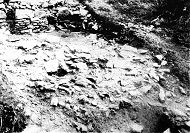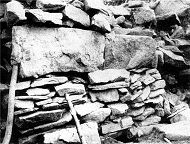Celtic Settlement of Třísov
The Celtic settlement of Třísov dating from the Primeval Times belongs to one of the most outstanding locations in South Bohemia. During the 2nd century BC the Celts represented by Bójové Tribe reached a very high standard of association in Bohemia, as evidence of suburban type fortified settlements called "oppida". The most important locations are situated along the Vltava river, for example, Závist near Prague, Hrazany, Nevězice and Třísov. Place left between individual locations is not fortuitous and is closely connected with the thoroughfare which used to joined Bohemia Hollow and the area called "Poddunají", and other southern locations.
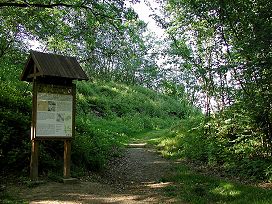
|
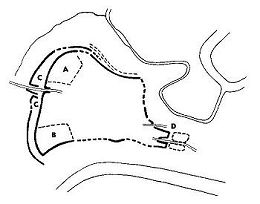
|
The Prehistory Seminar of German University in Prague led by Camilla Streit started the archaeological research of the settlement of Třísov before World War 2. The Prehistory Department of the Prague National Museum led by dr. Jiří Břeně did the systematic research of the location during the years 1954 - 1981. Most of the discoveries are displayed in the National Museum. Today the settlement of Třísov ranks among National Treasures, and any damage done is punishable.
The settlement of Třísov was built strategically on the confluence of the Vltava river and the Křemežský stream around the half of the 2nd century BC. However, it reached its prime in the 1st century BC. The settlement area has about 26 hectares. The fortification in the form of mounds is still preserved in the west and east side of the settlement. The fortification in the south and north was not probably built very properly - the location is protected by sheer steep hills. There are two acropoles in the north-west and south-west corner-piece settlement. The settlement was an important regional industrial centre attached to the chain of long distance trade , and played an important role in the religious life during its prime. The settlement of Třísov could not exist isolated. Although its inhabitants were partly engaged in farming , they were dependent on agricultural settlements which formed their base. To discover the origin of their civilisation is only incipient. The settlement extinction is probably related to the Celtic rule decline in Bohemia during the second half of the 1st century BC. Presumably it did not become extinct because of the act of violence but it was abandoned.
|
|
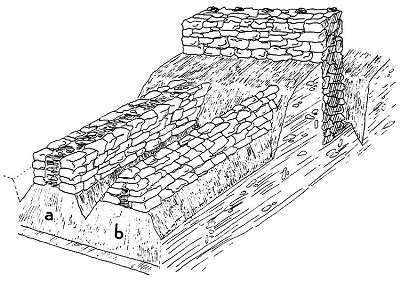
|
The fortification played a key importance in every Celtic settlement. The most powerful fortification was built in its west outskirts which was easily accessible. Nowadays there are only two lines in the form of mounds left. They arose from the original barrier which fell to pieces gradually. The archaeological research allowed us to get to know the original appearance of the fortification - the loose stone-and-clay mound reinforced with the wooden construction and secured with the front stone wall.
The inside bulwark was 7 metres wide at its base. The front stone wall was strengthened with vertically countersunk beams at a distance of 150 cm. The face of the bulwark was preserved up to the height of 160 cm in the searched section. The wooden bulwark is still recognisable above the stone wall.
The outside bulwark was built up similarly. The territory between both fortified lines is filled up with moats and regularly occurred low ridges. Those should probably be last bits of ruined walls which protected the territory between both fortified lines against invader attacks. Such a factor of defence is completely rare in Celtic settlements.
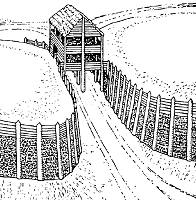
|
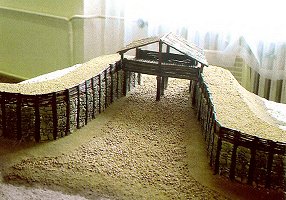
|
There were two gates which enabled to enter the site of a fortified settlement from the west. The gate called "pincer gate" is very simple - fortified with the stone wall , strengthened mound ends are broke at a right angle into the inside settlement area. A wooden tower with a gate could have been between them. The inside thoroughfare was paved over with some boulders. The outside gate is more complex in its construction. The mound ends are broke irregularly and an oblique mound bulk between them narrows down the access and separates a risen well.
There is far less information about the settlement fortification in the east. The original gate was partly preserved. There are two separate bulwarks. The location has not been searched so far.
We do not have a vast amount of knowledge about the architecture which has appeared in Bohemia settlements. All pieces of information come from the reversed foundations of the buildings uncovered during the archaeological researches. The existence of stone buildings has not been proved so far. Timber chalets and buildings with a pile construction and original earthen walls have been proved. We do not know too much about over-ground parts. However, some of them must have been quite large. In the settlement of Hrazany the size of the ground plans was up to 15 x 12 metres, and the foundation of some buildings built on the stone base walls was up to 21 metres long. It is very common to see small cottages with floors sunk under the neighbouring ground level in settlements. In the Celtic settlement of Třísov used to be residential buildings , some of them built on the stone base walls, mostly near the fortification. The inside settlement area may have been covered with out-buildings in the size of 7-9 x 3-4 metres with a pile construction.
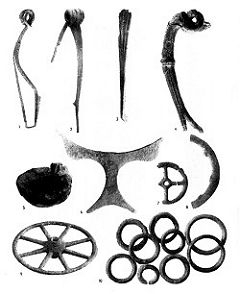
|
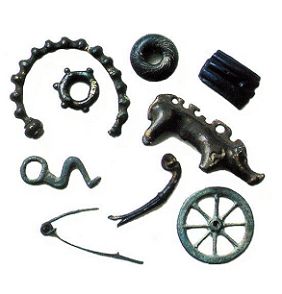
|
The northern acropolis of the settlement could have been a place of the cult. The archaeologists uncovered a ground plan of an octohedral building with a wooden pile construction which can be regarded as the holy of holies.
Celtic settlement areas are thought to be have been regional centres of handicraft. The settlement of Třísov ranged with them. Pottery production reached a high level in its technology. A large number of pottery vessels were made on the potter´s wheel and baked in the vertical-type furnace with a grate which separated the fire-box from the charge. Pot-shaped forms, bowls and bottles are represented most. Graphite goods ( mixture of graphite and clay ) are very typical for Třísov pottery. Luxurious pottery goods with painted ornaments were excavated in the settlement of Třísov in addition to utility pottery.
Iron making reached a very remarkable stage of development. Iron was made in special workshops outside the settlement area. However, black-smithes worked in settlements. Their craft job is shown by many kinds of tools, equipment, arms , different mountings and sheathings and other things, for example, knives, scissors, razors, axes, scythes, shares, knives of the coal-plough, horse curbs, etc. Iron goods were used in agriculture, wood processing industry and households. Iron could not been replaced while making arms and armours, for example, arrow spikes, lances , spurs, etc.
Metal process of production and non-ferrous metals processing reached a high stage of development as well. Little decorative and utility objects were made of bronze. Fasteners are very common to be found during the excavation work. Some of them are even regarded to be jewellery . They were made of iron or precious metal , for example, pendants, bracelets, rings, brooches, clasps, combs, mirror fragments and other different things. Miniature animal and human ornamental sculptures were also made of bronze. A large number of casting form fragments and waste of production from a workshop were found in the settlement of Třísov.
Glass making also reached a considerable prosperity. Many coloured bracelets, rings, beads and pearls were made of blue, yellow and green glass material. Plenty of them come from Třísov. Bone processing used for making awls, fish hooks, smoothing tools or even playing stones reached a high level prosperity. Products made of bones were preserved very rarely in the settlement of Třísov. Textile process of production is provable by many earthen whorls.
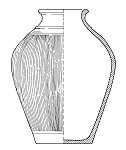
|
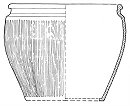
|
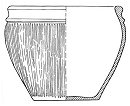
|
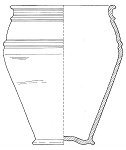
|
Trade played an important part of the life in the settlement of Třísov. Import goods from Rome provinces - pottery miner´s safety lamp fragments and bronze vessel fragments were excavated. Money was illustrated by rare findings of gold, silver and bronze coins or portable scales.
(jm)
Further information:
Archaeological
Researches in the Český Krumlov Region
Primeval
Settlement in the Český Krumlov Region


